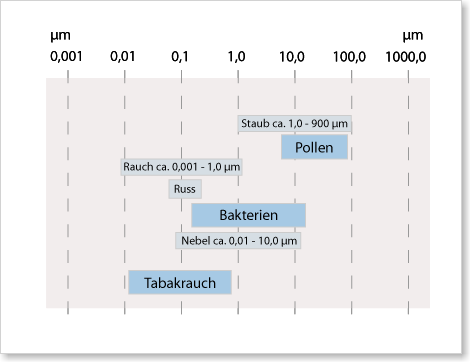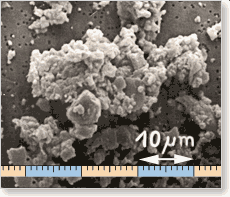 Particles of 100 microns over (coarse dust as sand, seeds, etc.) are still perceived by the human eye. They fall to the ground relatively quickly (a few minutes).
Particles of 100 microns over (coarse dust as sand, seeds, etc.) are still perceived by the human eye. They fall to the ground relatively quickly (a few minutes).
 Particles deposit greater than 10 microns off until they are disturbed and fall to the ground after a short time (a few minutes).
Particles deposit greater than 10 microns off until they are disturbed and fall to the ground after a short time (a few minutes).
 particles less than 10 microns (aerodynamic diameter) often stay on at ground level and then remain indefinitely in the atmosphere (several hours). Such particles are only partially visible and are made of smoke or dust.
particles less than 10 microns (aerodynamic diameter) often stay on at ground level and then remain indefinitely in the atmosphere (several hours). Such particles are only partially visible and are made of smoke or dust.
 particles 0.1 to 1 micron to a slow fall velocities (several hours).
particles 0.1 to 1 micron to a slow fall velocities (several hours).
 Particles of less than 0.1 microns behave like gas molecules. They do not decrease, but will they meet with other molecules by moving (Brownian motion).
Particles of less than 0.1 microns behave like gas molecules. They do not decrease, but will they meet with other molecules by moving (Brownian motion).

The dust that we see on horizontal surfaces in a room sets, primarily from larger particles together> 10 microns, the particles can also be composed of smaller parts that have accumulated.
Such dust deposition - collections can be caused by mechanical forces (eg by sweeping with a broom or by road) again to release smaller particles.
Such dust deposition - collections can be caused by mechanical forces (eg by sweeping with a broom or by road) again to release smaller particles.

 In the picture you can see that the small particles are bundled and have formed particles larger than 10 microns.
In the picture you can see that the small particles are bundled and have formed particles larger than 10 microns.
The image shows windblown dust (Food Logistics).
The white bars in the picture are 10 microns long.




